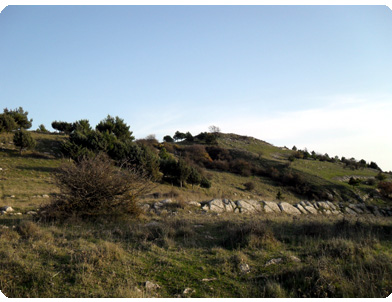 |
Is there a
silent place where you may sense around you almost tangible presences,
remain captured by them, but cannot evoke and describe them in words?
Yes, it’s Monte Chiodo, an archaeological site on top of a mountain
above Buonalbergo town. But if you want to perceive those presences,
when there you must keep your eyes shut and sharpen your hearing faculty;
and then you will hear in the wind sheep bleating, dogs barking and
whining, cows mooing, but also men’s shouts and songs.
You go on climbing toward the mountain top and from afar you may already
discern white stones arranged in lines, among the luxuriant meadow which
covers the western mountain flank. Those stones are unequivocal signs
destined ever since the beginning for a long trip in time and history.
The area constituted by the mountain crest and its higher flanks is
clearly divided in three parts, each of them destined for a separate
function, as it was the case in pre-Roman settlements of ancient Samnium:
the hill fort, a sanctuary dedicated to the cult of some Italic deity,
and a village made up of scattered huts.
The most relevant structure of this archaeological site is the hill fort.
It covers almost entirely the mountain crest. Its form is a very large
trapezium, whose southern side is flanked by a spacious cistern for
storing rain water.
The sanctuary southern side wall shows a curvature which might have been
either a church “apse” basement, or the outer wall of the pristine
Italic temple “cella”. This dilemma is still requiring resolution, but
we think that also the sanctuary walls, which clearly are a work of
cyclopean masonry, pertain to the typical settlements of ancient Samnium.
|